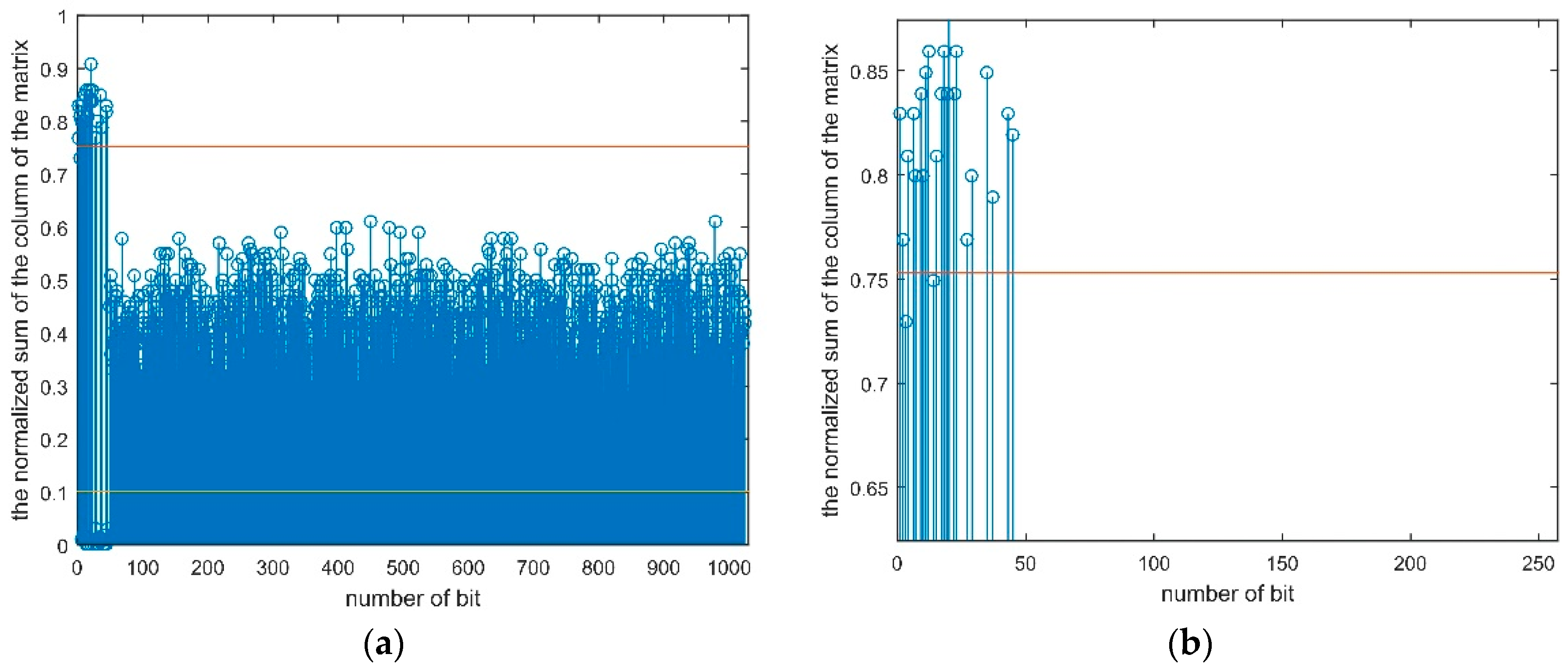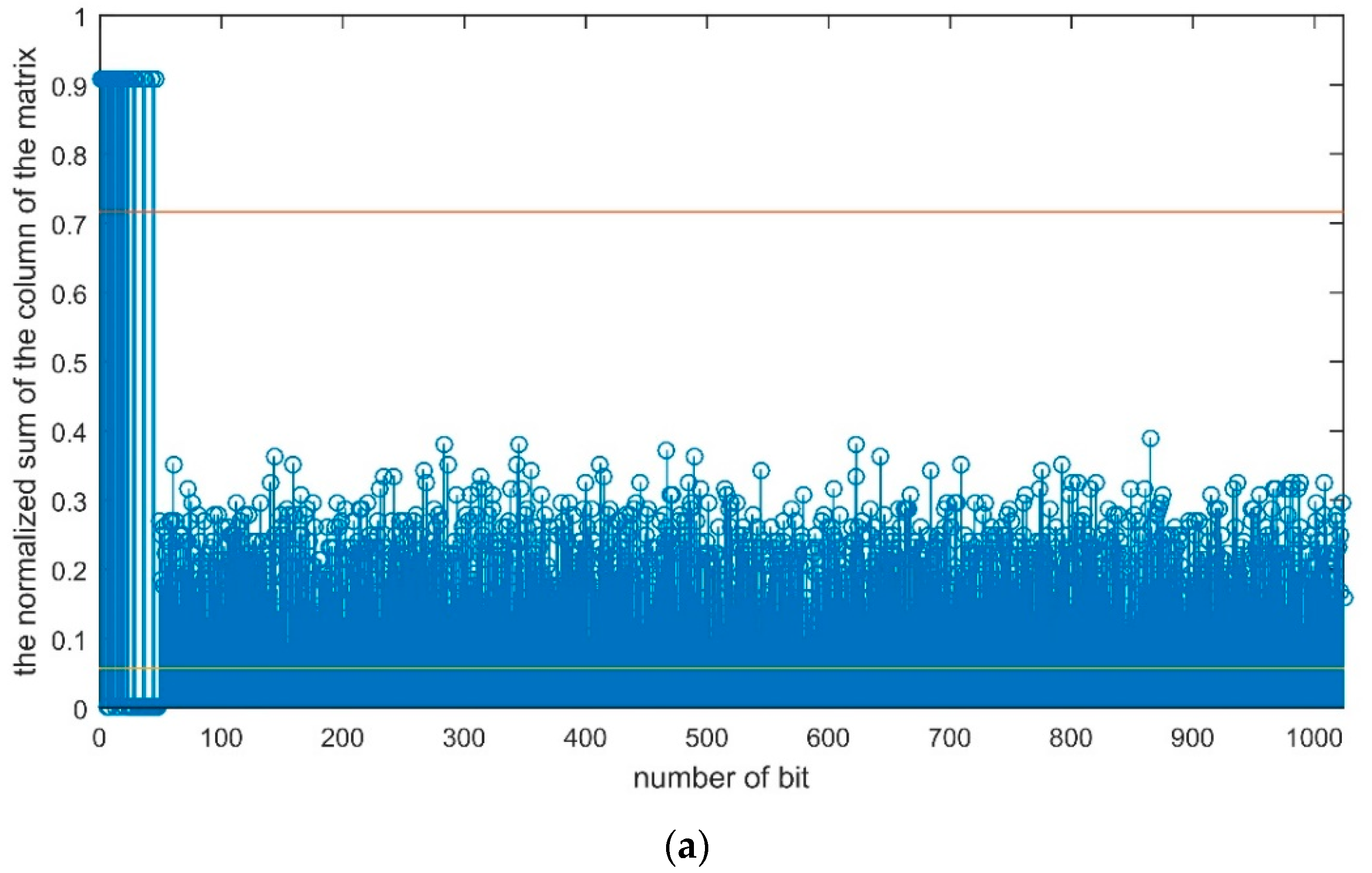An Improved Blind Recognition Algorithm of Frame Parameters Based on Self-Correlation
Abstract
:1. Introduction
2. The Cumulative Filtering Algorithm
3. Frame Parameters Recognition Algorithm Based on Self-Correlation
4. Improved Frame Parameters Recognizing Algorithm Based on Self-Correlation
5. Simulation
6. Conclusions
Author Contributions
Funding
Conflicts of Interest
References
- Cassaro, T.M.; Georghiades, C.N. Frame synchronization for systems over AWGN channels. IEEE Trans. Commun. 2004, 52, 484–489. [Google Scholar] [CrossRef]
- Lui, G.L.; Tan, H.H. Frame synchronization for Gaussian channels. IEEE Trans. Commun. 1987, 35, 818–829. [Google Scholar]
- Mostofa, M.; Howlader, K. Frame synchronization of convolutionally coded systems for packet transmission. IEEE Commun. Lett. 2001, 5, 307–309. [Google Scholar]
- Massey, J.L. Optimum Frame Synchronization. IEEE Trans. Commun. 1972, 20, 115–119. [Google Scholar] [CrossRef] [Green Version]
- Guo, K.F.; Meng, W. Research on Detection of Frame Head on Fixed Frame Length. J. Signal Inf. Process. 2014, 44, 33–36. [Google Scholar]
- Cluzeau, M.; Finiasz, M. Recovering a Code’s Length and Synchronization from a Noisy Intercepted Bitstream. In Proceedings of the IEEE International Symposium on Information Theory, Seoul, Korea, 28 June–3 July 2009. [Google Scholar]
- Imad, R.; Houcke, S. Theoretical Analysis of a MAP Based Blind Frame Synchronizer. IEEE Trans. Wireless Commun. 2009, 8, 5472–5476. [Google Scholar] [CrossRef]
- Qi, Y.; Wang, B.; Rong, M.; Liu, T. Comments on “Theoretical Analysis of a MAP Based Blind Frame Synchronizer”. IEEE Trans. Wireless Commun. 2011, 10, 3127–3132. [Google Scholar]
- Qin, J.Y.; Huang, Z.P. Novel Blind Recognition Algorithm of Frame Synchronization Words Based on Soft-Decision in Digital Communication Systems. PLoS ONE 2015, 10, e0132114. [Google Scholar] [CrossRef] [PubMed]
- Zhou, K. Early chatter detection in end milling based on multi-feature fusion and 3σ criterion. Int. J. Adv. Manuf. Technol 2017, 92, 4387–4397. [Google Scholar]
- You, X.Y.; Yang, P.; Peng, J.W. Frame synchronization and symbol timing synchronization based on soft decision feedback in burst communication. Comput. Eng. Appl. 2018, 54, 96–100. [Google Scholar]
- Sheldon, M.R. A First Course in Probability, 8th ed.; China Machine Press: Beijing, China, 2014; pp. 127–134. [Google Scholar]
- Hamaguchi, K.; Shoji, Y.; Ogawa, H. BER performance of coherent-QPSK transmissions affected by phase noise from frequency converters. In Proceedings of the 54th IEEE Vehicular Technology Conference, Atlantic, NJ, USA, 7–11 October 2001. [Google Scholar]






© 2019 by the authors. Licensee MDPI, Basel, Switzerland. This article is an open access article distributed under the terms and conditions of the Creative Commons Attribution (CC BY) license (http://creativecommons.org/licenses/by/4.0/).
Share and Cite
Xu, Y.; Zhong, Y.; Huang, Z. An Improved Blind Recognition Algorithm of Frame Parameters Based on Self-Correlation. Information 2019, 10, 64. https://doi.org/10.3390/info10020064
Xu Y, Zhong Y, Huang Z. An Improved Blind Recognition Algorithm of Frame Parameters Based on Self-Correlation. Information. 2019; 10(2):64. https://doi.org/10.3390/info10020064
Chicago/Turabian StyleXu, Yiyao, Yang Zhong, and Zhiping Huang. 2019. "An Improved Blind Recognition Algorithm of Frame Parameters Based on Self-Correlation" Information 10, no. 2: 64. https://doi.org/10.3390/info10020064
APA StyleXu, Y., Zhong, Y., & Huang, Z. (2019). An Improved Blind Recognition Algorithm of Frame Parameters Based on Self-Correlation. Information, 10(2), 64. https://doi.org/10.3390/info10020064



